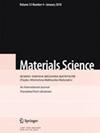Correlations Between XRD Peak Broadening and Elastic and Plastic Deformation for Mild Steel Sheets Under Tensile Loading
IF 0.7
4区 材料科学
Q4 MATERIALS SCIENCE, MULTIDISCIPLINARY
引用次数: 0
Abstract
The polycrystalline nature of steel sheets plays a fundamental role in their plastic behavior during forming, especially under complex stresses, such as the deep drawing process. Heterogeneous microstructures cause variable internal stress levels, which strongly impact the material’s macroscopic mechanical properties. X-ray diffraction (XRD) technique can be applied to determine microscopic internal stresses by peaks broadening analysis, which can be related to the degree of cold work at the microscopic level. As deep drawing is a complex deformation mode, an important motivating factor to perform such a study is to find the correlation between anisotropy and XRD peak broadening through tensile deformation tests. Therefore, the initial mechanical state and different deformed states were analysed by in-situ XRD peak broadening under tensile tests in various directions in the rolling plane of mild steel sheet, for both the elastic and plastic deformation domains. The results showed that the XRD peak broadening gives accurate estimations of deformation degrees. In the elastic domain, under realistic assumptions, a relation between the relative variation of peak broadening and the applied stress σ, like Hooke’s law, was obtained by exploiting the linearity between the peak broadening and the elongation measured by the strain gauge. This formula may be used to deduce The Young’s modulus. Interesting empirical relations between peak broadenings, macro deformations and hardness have been also established for the studied sheet in the plastic deformation region. Moreover, XRD peak broadenings were able to characterize the anisotropy of deformation in the rolling plane of the sheet. They are like the anisotropy coefficients in indicating the expected behavior under complex processes such as deep drawing by using ordinary tensile tests.拉伸载荷下低碳钢板的 XRD 峰宽与弹性和塑性变形之间的相关性
钢板的多晶特性对其成型过程中的塑性行为起着至关重要的作用,尤其是在复杂的应力条件下,例如深拉工艺。异质微观结构会导致不同的内应力水平,从而严重影响材料的宏观机械性能。X 射线衍射 (XRD) 技术可通过峰值展宽分析确定微观内应力,而微观内应力可与微观冷加工程度相关联。由于深冲是一种复杂的变形模式,因此进行此类研究的一个重要动机是通过拉伸变形试验找到各向异性与 XRD 峰展宽之间的相关性。因此,在低碳钢板轧制面上不同方向的拉伸试验中,通过原位 XRD 峰展宽分析了弹性和塑性变形域的初始力学状态和不同的变形状态。结果表明,XRD 峰值展宽可以准确估计变形程度。在弹性领域,在现实的假设条件下,利用峰值展宽与应变仪测得的伸长率之间的线性关系,可以得到峰值展宽的相对变化与外加应力 σ 之间的关系,就像胡克定律一样。该公式可用于推导杨氏模量。在塑性变形区域,峰值展宽、宏观变形和硬度之间也建立了有趣的经验关系。此外,X 射线衍射峰值展宽还能描述板材轧制面上变形的各向异性。它们就像各向异性系数一样,通过使用普通拉伸试验来显示深拉伸等复杂工艺下的预期行为。
本文章由计算机程序翻译,如有差异,请以英文原文为准。
求助全文
约1分钟内获得全文
求助全文
来源期刊

Materials Science
工程技术-材料科学:综合
CiteScore
1.60
自引率
44.40%
发文量
63
审稿时长
4-8 weeks
期刊介绍:
Materials Science reports on current research into such problems as cracking, fatigue and fracture, especially in active environments as well as corrosion and anticorrosion protection of structural metallic and polymer materials, and the development of new materials.
 求助内容:
求助内容: 应助结果提醒方式:
应助结果提醒方式:


